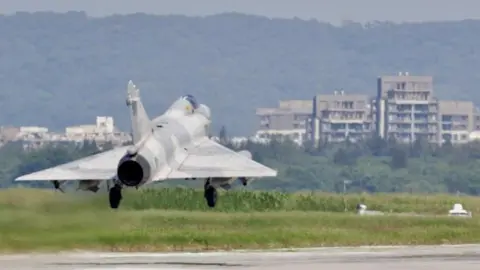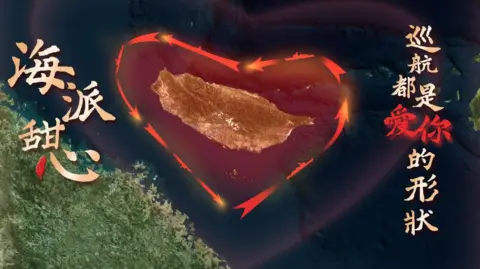
 EPA
EPAChina began new military exercises off the coast of Taiwan on Monday in what it described as “punishment” for a speech by its President William Lain, who vowed to “oppose annexation” or “oppose encroachment on our sovereignty”.
China claims the self-governing island of Taiwan as its own and its president, Xi Jinping, has vowed to take it back by force if necessary.
Taiwan said 34 naval vessels and 125 aircraft were deployed around the island on Monday.
Maps released by Chinese state media show its forces stationed around the entire island. It said later on Monday that the exercises had been completed successfully.
China’s military, known as the People’s Liberation Army (PLA), said the drills, involving all branches of the military, were designed to simulate an attack on Taiwan by land, sea and air.
Senior Captain Li Shi, spokesman for the PLA Eastern Theater Command, said the exercises “thoroughly tested the integrated joint operational capabilities” of its troops.
Taiwan’s airports and seaports operated as normal.
An earlier statement by Taiwan’s defense ministry condemned the Chinese move and said its priority was to avoid direct confrontations that could escalate the conflict. The outer islands are on high alert.
China’s Foreign Ministry confirmed the simulation of military strikes and port blockades, and described Taiwan’s independence as “incompatible” with peace in the region.
The Chinese Coast Guard later noted in a post on its Weibo account that the patrol route was heart-shaped.
 China Coast Guard
China Coast GuardChina has conducted several large-scale military exercises off the coast of Taiwan since 2022 and its warplanes regularly enter Taiwan’s airspace.
The latest exercise has been dubbed Joint Sword 2024-B by Beijing and has been widely anticipated since May, when exercises of the same name and officially designated A were staged.
The exercise, described by China as its largest ever, coincided with the inauguration of President Lai, long seen by Beijing as a “troublemaker” advocating for Taiwan’s independence.
His recent comments on Taiwan’s National Day were condemned by China, which said he was raising tensions with “bad intentions”.
While these exercises are widely expected, if you look at how close Chinese ships and aircraft are to Taiwan — as well as the fiery rhetoric — this is very aggressive behavior.
In any other context, this would be seen as a dramatic escalation – but it comes against a backdrop of already high tensions.
The US responded that there was no justification for the exercises after Lai’s “routine” speech and that China should refrain from further actions that could endanger peace and stability in the region.
The recent history of China’s military intimidation of Taiwan goes back to 1996, after Taiwan held its first direct presidential election. China declared several areas around Taiwan off-limits, and fired short-range ballistic missiles at areas along the northern and southern coasts.
US President Bill Clinton quietly moved US naval forces into the Taiwan Strait to demonstrate to Beijing that the US would deter an attack on the island.
Tensions eased significantly between 2008 and 2016 – until the chairmanship of Taiwan’s Democratic Progressive Party (DPP). Tsai Ing-wen Elected President. China views the DPP as a pro-independence party and responded by cutting off all direct ties with the government in Taipei.
The situation has continued ever since.
Speaker of the US House in August 2022 Nancy Pelosi flew into Taipei – This is the first time since 1997 that a cabinet speaker has visited the island. Pelosi’s visit and her outspoken support for Taiwan were seen as a major provocation by Beijing – the most senior US politician to formally endorse the government here.
It reacted with fury – holding two days of exercises and for the first time flying ballistic missiles over the island and into the Pacific Ocean.
